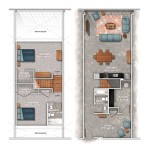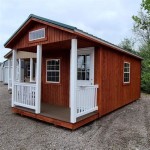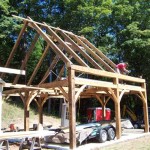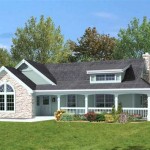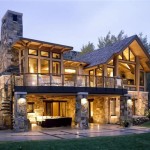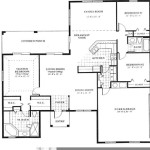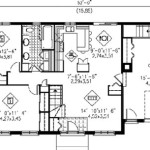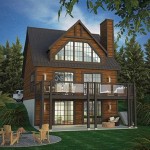```html
Small House Design Ideas With Floor Plan
The rising costs of land and construction, coupled with a growing desire for simpler, more sustainable living, have led to an increased interest in small house design. These homes, often defined as less than 1,000 square feet, present unique challenges and opportunities for architects and homeowners alike. Careful planning and innovative design solutions are crucial to maximizing space, functionality, and comfort within a limited footprint. Examining various design ideas and floor plans is essential for creating a small house that meets the specific needs and preferences of its occupants.
Efficient floor planning is the cornerstone of successful small house design. A well-designed floor plan optimizes the use of every square inch, minimizes wasted space, and creates a sense of openness and flow. Consideration must be given to the placement of essential elements such as the kitchen, bathroom, living area, and bedrooms. Furthermore, the relationship between these spaces should be carefully considered to ensure a comfortable and functional living environment.
Optimizing Space with Open Floor Plans
One of the most popular and effective strategies for small house design is the open floor plan. This approach eliminates or minimizes interior walls, particularly between the living room, kitchen, and dining area, creating a larger, more unified space. The absence of walls allows natural light to permeate the entire area, making it feel brighter and more spacious. Open floor plans also facilitate social interaction and create a more inclusive atmosphere.
However, open floor plans require careful consideration of zoning and functionality. Defining distinct areas within the open space is crucial to prevent it from feeling chaotic or undefined. This can be achieved through various design elements, such as changes in flooring, the strategic placement of furniture, or the use of area rugs. For instance, a kitchen island can serve as a visual and physical divider between the kitchen and living area while also providing additional counter space and storage.
The furniture selection for an open floor plan is also critical. Choosing multi-functional pieces, such as a sofa bed or a coffee table with storage, can help to maximize space and reduce clutter. It is also important to scale furniture appropriately to the size of the room. Oversized furniture can overwhelm a small space and make it feel cramped, while undersized furniture may look out of place and fail to provide adequate functionality.
Leveraging Vertical Space and Storage Solutions
In a small house, maximizing vertical space is essential for creating additional storage and living areas. High ceilings can create a sense of spaciousness and allow for the installation of lofts or mezzanines. Lofts can be used as sleeping areas, home offices, or extra storage space, depending on the specific needs of the homeowner. However, careful consideration must be given to accessibility and safety when designing a loft, including the installation of a sturdy staircase or ladder and appropriate railings.
Storage solutions are paramount in small house design. Built-in storage, such as shelves, cabinets, and drawers, can maximize space and minimize clutter. Utilizing wall space for storage is particularly effective, as it keeps items off the floor and creates a cleaner, more organized appearance. Consider incorporating storage into unexpected places, such as under stairs, benches, and window seats.
Another innovative storage solution is the use of modular furniture. Modular furniture pieces can be easily reconfigured to adapt to changing needs and can provide hidden storage compartments. For instance, a modular sofa can be arranged in various configurations to create different seating arrangements, and some modules may even include built-in storage for blankets or pillows. Similarly, modular shelving units can be customized to fit specific spaces and storage needs.
Incorporating Natural Light and Outdoor Connections
Natural light can significantly impact the perceived size and feel of a small house. Maximizing natural light can make a small space feel brighter, more open, and more inviting. Large windows, skylights, and glass doors can all be used to bring natural light into the home.
The placement of windows is also crucial. Windows should be strategically positioned to capture the most sunlight throughout the day. South-facing windows are ideal for maximizing solar gain in colder climates, while east-facing windows can provide morning sunlight. Skylights are particularly effective for bringing natural light into areas that may not have access to windows, such as hallways or bathrooms.
Connecting the interior of the small house with the outdoors can also enhance the sense of space and create a more enjoyable living environment. A small patio or deck can extend the living area and provide a place to relax and entertain outdoors. Large glass doors can create a seamless transition between the interior and exterior spaces, blurring the boundaries between the two. Furthermore, incorporating landscaping and greenery into the outdoor design can create a more natural and tranquil setting.
Consider the integration of indoor plants as well. Plants can purify the air, add a touch of nature to the interior, and create a more calming atmosphere. Vertical gardens are a particularly effective way to incorporate plants into a small space, as they take up minimal floor space and can add visual interest to walls.
In summary, designing a successful small house requires careful planning, creative solutions, and a focus on functionality and efficiency. By optimizing space with open floor plans, leveraging vertical space and storage solutions, and incorporating natural light and outdoor connections, it is possible to create a small house that is both comfortable and aesthetically pleasing. The key is to prioritize essential needs, minimize clutter, and maximize the use of every square inch.
Before beginning a small house design project, it is crucial to create a detailed floor plan that takes into account the specific needs and preferences of the occupants. Consider the number of people who will be living in the house, their lifestyle, and their storage requirements. The floor plan should also reflect the local climate and site conditions. Working with an experienced architect or designer can be invaluable in creating a floor plan that is both functional and aesthetically pleasing.
Finally, remember that small house design is not just about minimizing space; it is about maximizing the quality of life. By carefully considering the design principles outlined above, one can create a small house that is both beautiful and functional, and that provides a comfortable and sustainable living environment.
```
30 Best Modern House Floor Plans Ideas Small Design

Pin On One Bedroom House Plans

10 Small House Plans With Open Floor Blog Homeplans Com

Small House Plan Examples

10 Small House Plans With Open Floor Blog Homeplans Com

Modern Small House Design

Small House Design Series Shd 2024008 Pinoy Eplans

These Small House Plans Pack A Lot Of Punch Houseplans Blog Com

27 Adorable Free Tiny House Floor Plans Craft Mart

Small House Plan Examples

